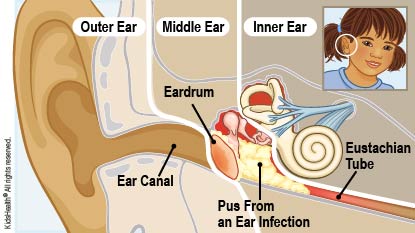Middle Ear Infection: How to Care for Your Child
When a child has a middle ear infection, the space behind the eardrum (called the middle ear) fills with pus (infected fluid). Sometimes it goes away on its own. Other times it needs to be treated with antibiotics. Health care providers decide how to treat based on many things, such as your child's age, how sick your child seems, how long the infection has lasted, and how often your child has ear infections.


-
If antibiotics were prescribed, be sure your child takes all the doses exactly as directed, even if he or she is feeling better. This is the best way to kill the harmful bacteria.
-
Encourage your child to drink plenty of fluids.
-
If your child has pain or is uncomfortable from fever, a medicine may help:
-
If your child has an ongoing medical problem (for example, a kidney, liver, or blood problem): Check with your health care provider before giving medicine for pain or fever.
-
For children younger than 3 months: Check with your health care provider before giving medicine for pain or fever.
-
For children 3–6 months: You may give acetaminophen (such as Tylenol® or a store brand).
-
For children older than 6 months: You may give acetaminophen (such as Tylenol® or a store brand) OR ibuprofen (such as Advil®, Motrin®, or a store brand).
-
Don't give aspirin to your child or teen because it has been linked to a rare but serious illness called Reye syndrome.
-
Follow up as recommended by your health care provider.

Your child:
-
still has pain or fever after 2–3 days, whether on an antibiotic or not
-
has fluid or blood coming from the ear
-
isn't drinking
-
vomits more than a few times in 24 hours
-
seems to be getting sicker (for example, can't be comforted or is very sleepy)

Your child:
-
appears dehydrated; signs include dizziness, drowsiness, a dry or sticky mouth, sunken eyes, crying with few or no tears, or peeing less often (or having fewer wet diapers)
-
has a swollen or red ear, or pain and redness over the bone behind the ear
-
has neck pain or seems to have a stiff neck

What causes middle ear infections? Middle ear infections — also called otitis media (oh-TYE-tis ME-dee-ah) — usually happen when germs (viruses or bacteria) from the back of the nose or throat spread into the ear. The middle ear is connected to the back of the throat by a small tube called the eustachian tube. Colds and allergies can make the eustachian tube swell or get blocked. This can lead to a buildup of mucus in the middle ear. Germs that spread from the nose or throat grow in the blocked mucus, causing an infection.
What are the symptoms of a middle ear infection? Buildup of fluid or pus behind the eardrum causes an earache. A child also might have a fever, vomiting, diarrhea, and trouble eating, drinking, or sleeping. Younger kids and babies may simply be fussy (cry more than usual). Fluid or pus behind the eardrum can make it hard to hear. If enough builds up, the eardrum can rupture (tear). In this case, fluid will drain from the ear, and the child might feel dizzy or nauseated, with ringing or buzzing in the ear.
How are middle ear infections treated? Some ear infections are treated with antibiotics, but many can go away without antibiotics. So the health care provider may recommend that you watch your child for a day or two to see if your child gets better without antibiotics. If your child's symptoms don't get better or they get worse, antibiotics will be started. A torn eardrum usually heals on its own very quickly.
How can I prevent my child from getting another middle ear infection? To reduce the risk of another middle ear infection:
-
Don't smoke or allow others to smoke around your child. If anyone in your household smokes, call 1-800-QUIT-NOW (800-784-8669) or visit www.smokefree.gov for advice and tips on quitting.
-
Breastfeed babies, if possible. If bottle-feeding, hold your baby at an angle (so the head is above the belly) and not horizontally. And don't give your baby a pacifier after 6 months of age.
-
Make sure your child gets all recommended vaccines (shots).
Middle ear infections are not contagious (cannot be spread to others), but a cold or other virus that can cause an ear infection is contagious. To prevent spreading colds and other viruses:
-
Remind all family members to wash their hands well and often. They should use soap and water and scrub hands for at least 20 seconds, rinse, and dry thoroughly. If soap and water are not available, a hand sanitizer with at least 60% alcohol can be used.
-
Help your child stay away from other people with colds, if possible.
-
Clean tabletops, doorknobs, and other hard surfaces regularly. Use a cleaner that kills viruses.
-
If your child goes to child care, check to make sure that objects and surfaces are cleaned often and that tissues, soap and water, paper towels, hand sanitizer, and throwaway wipes are easy to find.
Are there other kinds of ear infections? Yes. The outer ear can be infected, which is common in kids who swim a lot. This is known as otitis externa. The inner ear also can get infected, which can cause dizziness and problems with balance or hearing. But when health care providers say "ear infection," they usually mean an infection in the middle ear.